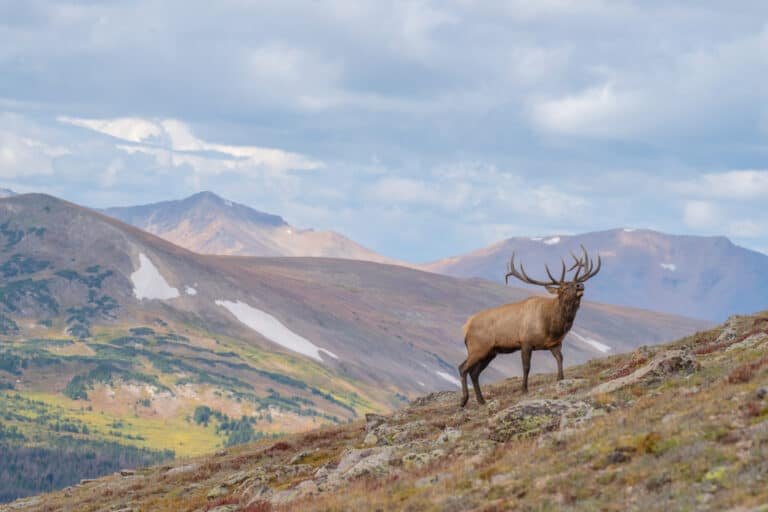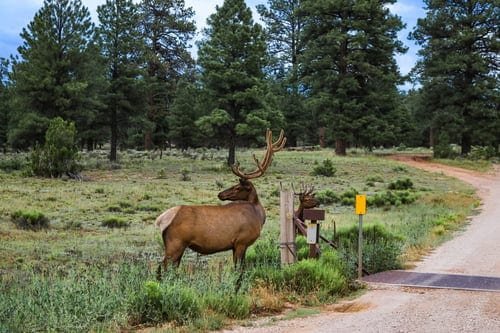Mastering the Art of Elk Hunting – Secrets You Should Know
Elk are one of the largest land mammals in North America. These magnificent creatures have captivated hunters for centuries with their imposing antlers and graceful presence. In this blog, will discuss elk hunting tips to support your journey.

Physical characteristics and size variations
Elks possess distinct physical features that contributing to their captivating presence in the wild. Both males and females sport impressive antlers, but those of bulls are notably larger, reaching lengths up to four feet or more. These formidable antlers can help establish dominance during rutting season when males fiercely compete for mating rights.
Additionally, elks display a reddish-brown or tan coat with a darker mane-like patch on their necks. Their fur provides excellent insulation against harsh weather conditions while adapting to seasonal color changes for improved camouflage.
Habitat preferences and distribution
Elks inhabit diverse ecosystems throughout North America, including forests, meadows, mountainsides, and even shrublands. They prefer regions offering ample grazing opportunities alongside water sources for hydration.
Their distribution spans various states in the United States, such as Colorado, Montana, Wyoming, Oregon, Idaho, and Washington. Additionally, elks can be found in parts of Canada, such as Alberta and British Columbia.
Elk’s behavior and communication
Elk behavior is fascinating as they display intricate social structures within their herds. During rutting season, which typically occurs from late summer to early fall, bull elks engage in fierce battles to establish dominance and win the attention of potential mates.
These confrontations often involve locking antlers and engaging in impressive displays of strength. Elk communication primarily revolves around vocalizations and body language. Males emit various calls during rutting season, including bugles, grunts, and barks. Each call serves a distinct purpose: attracting mates or warning other males to back off.
Additionally, body language plays a crucial role in elk communication, with behaviors such as head posturing and aggressive displays as indicators of dominance or aggressive intent. Understanding the intricacies of elk behavior and communication is essential for successful hunting ventures as it allows hunters to anticipate movements and interpret the signals these magnificent creatures exhibit.
Licensing and Regulations
Elk hunting is a highly regulated activity that requires adherence to licensing and regulations to ensure the sustainability of the elk population and maintain a fair, ethical, and safe hunting experience.
Before embarking on an elk hunting adventure, one must familiarize oneself with the specific licensing requirements in the desired hunting area. Different licenses are available depending on gender (bull or cow), weapon choice (archery or rifle), and even specific seasons or areas designated for special hunts.
For instance, bull licenses are typically limited in number and often require successful participation in a lottery draw. These licenses allow hunters to pursue mature male elk during the specified season dates.
On the other hand, cow licenses are usually more widely available as they contribute to population management efforts by targeting female elk. Archery enthusiasts have their own set of licenses, allowing them to test their skills with bows and arrows, while rifle hunters can opt for firearms suitable for elk hunting.
Understanding season dates is crucial as it ensures compliance with legal requirements and contributes to effective wildlife management practices. Season dates can vary depending on the region, aiming to preserve breeding times, migration patterns, habitat restoration efforts, and other factors necessary to maintain healthy elk populations.
Additionally, bag limits specify how many animals can be harvested per hunter during a particular season. These limits consider population densities, wildlife agencies’ herd health assessments, conservation objectives, and other factors.
Elk Hunting Tips – Gear and Equipment Essentials
Choosing appropriate gear and equipment plays a significant role in ensuring a successful and enjoyable elk hunting experience. For firearms enthusiasts participating in rifle hunts, selecting the right caliber is essential.
Popular choices include .270 Winchester or .30-06 Springfield due to their versatility in different terrains and distances; however, some experienced hunters prefer magnum calibers such as .300 Win Mag or 7mm Rem Mag for their extended range capabilities.
To enhance accuracy and target acquisition, hunters often equip their rifles with quality scopes. Optics with magnification ranges suitable for close-range encounters, long-distance shots, and dependable reticles contribute to a hunter’s effectiveness in the field.
Additionally, ammunition choices should be carefully considered, favoring high-quality rounds that provide adequate energy and expansion upon impact. For those opting for archery hunts, selecting the right bow is critical.
Compound bows offer speed and accuracy advantages due to their mechanical components, such as pulley systems. Traditional recurve or longbows can also be used but require additional expertise.
Choosing arrows appropriate for elk hunting is paramount, considering factors like weight, spine stiffness, and broadhead compatibility. Fixed-blade broadheads are preferred due to their reliability in penetrating elk hide and causing lethal damage.
Elk hunting often involves spending significant amounts of time in various weather conditions ranging from scorching heat to cold. Therefore, clothing choices should prioritize layering systems that allow easy adaptation to changing weather conditions.
Base layers made from moisture-wicking materials help regulate body temperature by wicking away sweat in warmer climates while providing insulation when it gets colder. Comfortable and durable boots are necessary for traversing rugged terrains during an elk hunt.
Opting for waterproof boots with excellent ankle support ensures protection from wet conditions and helps prevent potential injuries in challenging landscapes. A good-quality backpack allows hunters to carry essential gear such as water, food supplies, first aid kits, navigation tools (maps or GPS), game bags for meat preservation purposes, and other items required during extended hunts.
Investing in a quality pair of binoculars is highly recommended when tracking elk through vast landscapes or identifying games at considerable distances. Binoculars aid in spotting elusive animals while reducing eye strain caused by constant visual scanning.
Elk Hunting Tips – Physical Fitness Considerations
Elk hunting demands physical fitness and endurance due to the often demanding terrain, high altitudes, and the need to cover substantial distances while carrying gear. Engaging in regular endurance training is vital for maintaining stamina during prolonged hunts.
Cardiovascular exercises like running, hiking, or cycling enhance lung capacity, cardiovascular health, and endurance. Strength training exercises should not be neglected as they contribute to the ability to carry heavy backpacks or equipment over rugged landscapes.
Focusing on building core strength, upper body strength (particularly arm and shoulder muscles), and leg muscles can significantly improve a hunter’s performance in challenging situations. Moreover, acclimatizing to high-altitude environments is crucial for individuals hunting in mountainous regions.
I am spending time at higher elevations before the hunt, which allows the body to adjust gradually to reduced oxygen levels. This adaptation minimizes the risk of altitude sickness symptoms such as headaches, dizziness, or shortness of breath.
Adequate hydration during acclimatization and throughout the hunt also aids in adjusting more smoothly to high-altitude surroundings. By prioritizing physical fitness preparations and acclimatization measures, hunters can enhance their overall experience while ensuring their safety and reducing potential risks associated with strenuous outdoor activities like elk hunting.
Elk Hunting Techniques
Scouting for Elk
Proper scouting is crucial for success when embarking on an elk hunting expedition. Utilizing maps and GPS navigation tools can significantly enhance your chances of locating elk in their preferred habitats. Familiarize yourself with topographic maps and satellite imagery to identify potential hunting areas, such as meadows, ridges, or densely forested regions where elk may seek cover.
GPS devices allow you to mark important locations like water sources or clearings where elk will likely gather. While scouting, it is essential to keep an eye out for signs that indicate the presence of elk.
Tracks left behind by these magnificent creatures can reveal their direction of travel and proximity. Look for fresh imprints in muddy or soft ground, paying attention to size variations between bull and cow tracks.
Additionally, keep an eye out for rubbing posts where they scrape their antlers against trees or bushes to mark territory or remove velvet from their antlers before the rutting season begins. Another valuable tool in your scouting arsenal is game cameras.
These devices allow you to monitor specific areas over extended periods without disturbing the wildlife. Strategically placed game cameras near water sources or frequent elk crossings can provide valuable insights into movement patterns and help determine the best locations for setting up blinds or stands.
One last note here – pay attention to bears if they are in your hunting territory.
Stalking Techniques
Once you have located a promising area with signs of elk activity, employing effective stalking techniques becomes paramount. The key is stealth and awareness of wind direction – elks possess a keen sense of smell that can easily detect human presence if not properly managed.
Approaching silently involves minimizing noise by slow, deliberate movements through underbrush or trails devoid of dry leaves and twigs that may give away your position. Utilize techniques such as heel-to-toe stepping and placing your foot down gently to reduce sound vibrations.
Wind direction awareness is critical in elk hunting. Always approach from a downwind position to ensure that your scent is not carried towards the elk.
Consider using wind detection devices, such as powders or smoke sticks, to determine wind direction accurately before closing in on your target. Camouflage techniques aid in blending seamlessly with the surroundings, rendering you less visible to elk.
Choose camouflage clothing that matches your hunting area’s specific foliage and terrain. Additionally, consider face masks, gloves, and hats that break up your silhouette and prevent any movement from catching the attention of these perceptive animals.
Calling Strategies
Calling is a popular technique employed by hunters to attract elk within range. Understanding the different types of calls and when to use them effectively can significantly increase your chances of a successful hunt.
Various calls replicate different vocalizations made by elk during different situations. For example:
Bugling calls imitate the unmistakable sound of an elk bull during rutting season and can be used effectively to locate or challenge bulls. – Cow calls mimic the vocalizations made by female elks and can be used to attract bulls during mating season.
Calf-in-distress calls simulate young elks in distress, triggering protective instincts in adult elks. Mastering these calls requires practice and understanding their appropriate usage based on prevailing conditions such as time of year and behavior patterns observed during scouting missions.
Conclusion
Using advanced scouting methods is crucial for a successful elk hunting expedition. This includes studying maps, employing GPS tools, and identifying signs from tracks and rub posts.
Leveraging game cameras for extended observation can offer a deeper insight into their movement patterns. Additionally, discreet stalking techniques can make a significant difference.
Being mindful of wind-direction approaches, choosing the right camouflage, and adapting calling strategies based on the situation are all essential. Pursuing these regal animals demands immense patience.
However, with meticulous preparation and strategy, those moments spent in awe-inspiring wilderness can become cherished milestones. Observing the splendor of elk in their natural habitat is a reward in itself.





